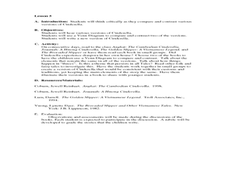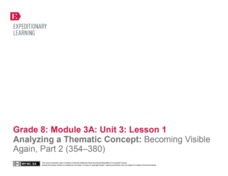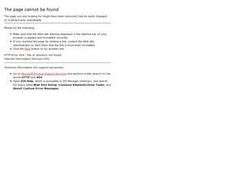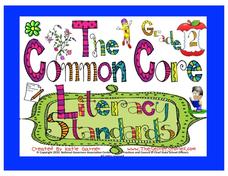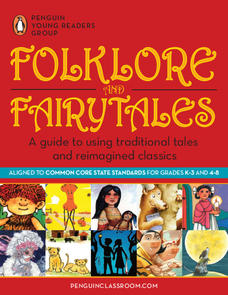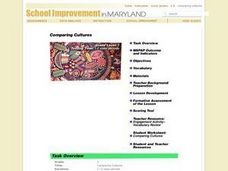Curated OER
Remembering What We Read
Students discover strategies to help them better understand the stories they read. As a familiar story is read to the class, individuals practice answering basic questions about the main characters, settings, problems, etc. while...
Curated OER
Fractured Fairy Tales
Students use familiar characters, plots, and settings from traditional fairy tales to create "fractured" versions, while experimenting with satire, irony and parody. A fractured fairy tale is designed to be humorous by changing the story...
Curated OER
Southeast Asian Folktales
Fifth graders locate and identify the countries of Southeast Asia on a map. In groups, they compare and contrast photographs and artifacts from their own lives with those living in Asia. They write their own folktales based off of...
Pennsylvania Department of Education
Using Literary Elements to Compare Fiction Texts
Students explore language arts by reading and reflecting on literary examples. In this fiction writing instructional activity, students read several different cultural versions of the story "Cinderella" and discuss their interaction with...
Curated OER
Falling Leaves: The True Story of an Unwanted Chinese Daughter
Learners read the novel Falling Leaves. They evaluate the repeated story lines which compose the history of narration. They analyze and defend reasons why self-esteem affects the success or failure of characters.
EngageNY
Analyzing a Thematic Concept: Becoming Visible Again, Part 2 (354–380)
Scholars take a close look at the life of Louie in Unbroken. They discuss events considered turning points in their life and use several graphic organizers and guides to help direct their thinking. After thinking about their responses,...
Curated OER
Dear Abby: A Direct and Indirect Characterization Lesson Plan
Students practice identifying and creating examples of characterization based on comprehension. They assess direct and indirect characterization and use conflict in a plot to generate a piece of writing. Each student selects accurate...
Curated OER
Cinderbank
Fourth graders identify major components of a "Cinderella" story in order to create a database.
Curated OER
Talking Heads
After processing notes from research or an interview, middle schoolers turn the information into a script or dialogue for narrative, persuasive, or expository text. Use this lesson in any writing unit to reinforce proper writing skills.
Curated OER
Fractured Fairy Tale Worksheet
Explore fairy tales using this worksheet. Learners read parts of traditional fairy tales and then write their own versions. They complete five fairy tales in this manner. What a motivating way to cover this concept.
Curated OER
The Common Core Literacy Standards - Grade 2 Posters
Support second graders with mastering the Common Core using this series of classroom displays. With each English language arts standard rewritten as a We can statement and accompanied by images and examples, this resource provides young...
Curated OER
The Magical World of Russian Fairy Tales
Students read several fairy tales of Russian origin. They brainstorm common elements of a fairy tale and identify those elements in several examples. They retell a favorite fairy tale through a skit, oral storytelling, a sketch, or a...
Curated OER
Writing Diagnostics and Introduction to Literary Terms
Assess your new learners' writing abilities and knowledge of literary terms with these diagnostic activities. Part of a back-to-school unit, this is meant to provide the teacher with information about the ability levels of their class....
Premier Literacy
Point of View
Incorporate technology into a literature activity with an innovative language arts activity. Middle schoolers read an electronic version of original stories or fairy tales, and after determining the point of view, rewrite the tale from a...
Penguin Books
Folklore and Fairytales: A Guide to Using Traditional Tales and Reimagined Classics
Every culture has its own stories to tell. An interesting educator's guide shares a large collection of fairytales and folktales, some from different cultures and some re-creations of classics. A summary and brief teaching ideas...
Curated OER
Comparing Cultures
Young readers compare two stories/cultures, identifying how they are alike and different. They share their own version of a well-known story and adapt it to another culture. They explain their adaptations.
Teaching English
Fairy Tales; Not Just for Kids
"Once upon a time . . ." Language learners examine the key elements of well-known fairy tales and then craft their own.
Curated OER
Fairy Tales Unit Ideas
Learners listen to children's fairy tales and watch them on a video. Afterward, they list the heroes from each story. Students write a short paragraph about a typical day for the hero. Learners dress up like their character and give a...
Curated OER
Ending a Famous Fairy Tale
Altering the ending of a famous fairy tale is a really fun way for kids to experience creative writing. The lesson plan here has them do just that! Learners listen to the famous fairy tale, "The Twelve Brothers," and change the ending of...
Curated OER
Short Story Elements
Students engage in a instructional activity that investigates the elements that are necessary in a short story. Each element is covered separately while they take notes for each part. Then the teacher points out each element while...
Curated OER
Elements of the Oral Tradition
Various genres of oral tradition are outlined and defined in these slides. Give your class examples of folk tales, fairy tales, parables, fables, legends, and myths before reading an example of one of these stories. This overview acts as...
Curated OER
Consistent Point of View (Avoid Pronoun Shifts)
He to you? She to they? Are your young writers starting their sentences with one type of pronoun and then shifting to another? Provide them with a worksheet that lets them practice maintaining a consistent point of view. The 14 exercises...
Curated OER
Into the Wild,
Students study the importance of point of view. They use a well-known fairy tale to explore how changing the point of view changes the whole story. They discuss what "point of view" means by asking: whose story is it? Whose eyes are we...
Curated OER
Once Upon a Time
Students use Inspiration to Identify the defining characteristics of Fairy Tales, They create a literary web, study the basic structure of plot, and recognize that themes reoccur across literary works. They complete Once Upon a Time...




